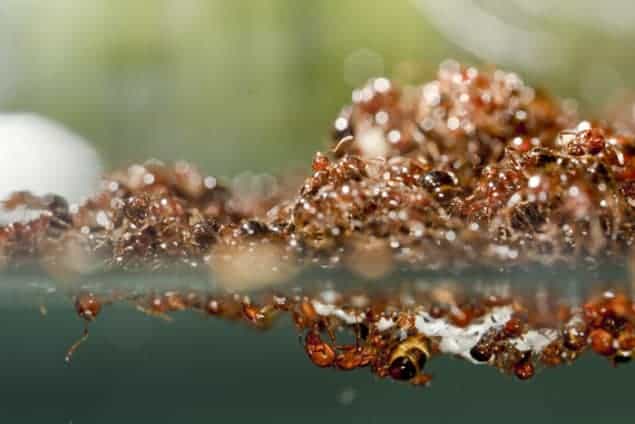
Aggregations of fire ants can, on a macroscopic scale, show some surprisingly classical material properties, such as viscoelasticity and flow, researchers in the US have demonstrated. The research gives, they say, a fascinating example of “active matter” – in which the individual elements are able to use energy and rearrange themselves – and could potentially provide insights for developing new materials.
Fire ants are known for their ability to organize into remarkable macroscopic structures. They can link their legs together into elastic solids that can resist macroscopic applied loads or self-assemble into rafts to survive floods. They have also been seen to form liquid-like aggregations, in one remarkable case “dripping” from a tap. “Lots of people have looked at the ants as a biological entity,” explains physicist Michael Tennenbaum of Georgia Institute of Technology in Atlanta. “But no-one has ever looked at the ants as a material.”
Ant gymnastics
In the latest work, Tennenbaum and colleagues studied various macroscopic properties of such aggregations. They placed a lead sphere on top of an aggregation of the ants and calculated the aggregation’s viscosity by measuring the speed at which the sphere sank through it. Next, the researchers placed the aggregation inside a rheometer, between two plates coated with Velcro. The ants gripped the Velcro tightly, meaning that rotation between the plates could be achieved only by shear of the aggregation. The researchers then applied a variable stress to the plates, finding similar – although not identical – viscosity. As expected, they also found that applying greater stress resulted in faster rotation (shear) between the plates, but the relationship was complex.
At relatively low shear, for example, a greater increase in stress was required to produce the same increase in shear; whereas at high rates, increases in shear could be achieved with a smaller increase in stress. In the language of classical physics, the viscosity of the aggregation decreased as shear increased. This phenomenon, called shear-thinning, is commonly observed in conventional viscoelastic materials. “If you did this experiment with jelly, you would get very elastic behaviour at really small strains, but at large strains you would get flow,” says Tennenbaum. Nevertheless, on a microscopic basis, the aggregation is nothing like a conventional viscoelastic material.
Playing dead
Ants are continuously moving around within the aggregation, regardless of whether or not it is under stress. While trying to resist an applied stress, the ants first grab one another’s limbs, thereby dissipating strain energy through the movement of their joints. When necessary, they let go of ants they can no longer safely hold on to and grab hold of other ants. At higher rotation rates, the aggregation is sheared faster than the ants can rearrange to resist the applied stress – in this case, the ants “play dead”, lying still and allowing their limbs to entangle randomly with each other, thereby creating a constant resistance to flow of about 70 Pa.
Indeed, when the researchers tried the experiment with dead ants, the aggregate showed similar resistance to flow at high rotation rates, but it did not show the elastic behaviour at small strains. The ants did show some behaviour that would not be seen in conventional matter, however. For example, at stresses below 70 Pa, the ants sometimes actively resisted the shear for a time, producing a very stiff aggregate. Then, for no apparent reason, they gave up and allowed themselves to flow. After a period flowing, however, they once more resisted the flow.
Active systems
The team is now working towards a microscopic picture of why this occurs, but David Hu, who is one of the principal investigators in the team, says that “ants change their minds”. According to him, the research is part of a larger effort to “really understand how active systems can make new kinds of materials”. “Ants can maintain stresses enough that they can build a raft to support thousands of members, a bivouac that’s 30 stories tall – for an ant – or a bridge; but when the going gets tough, they can just liquefy,” says Hu.
David Weitz of Harvard University in Massachusetts, who was not involved in the new work, describes the research as “interesting and very amusing”, adding that these are some of the first results achieved by “applying the techniques of classical materials science to a biological system like this”. He says the ultimate significance of the work, however, will depend on “what people can do by following up this line of inquiry”.
The research is published in Nature Materials.



